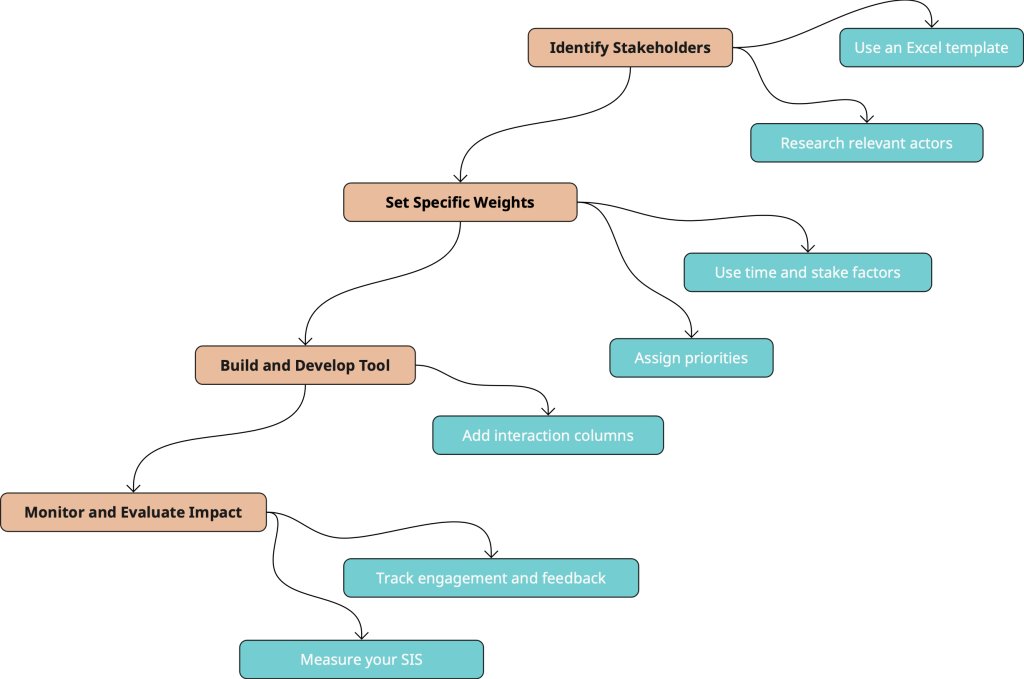Stakeholder mapping: 4-steps process and template attached
Whether you are a Public Affairs representative or the CEO of a small company, there is a range of internal and external stakeholders which may help you reaching your goals or prevent you from it. Stakeholders mapping is the process to identify relevant and unrelevant stakeholders for your goals, to classify them according to their relevance (“weight”) for the successful develpment of your project and to track your interactions with them.
In the following article you will find:
- Our proven 4-steps process to map your stakeholders
- A free stakeholder map template to use on your own
- Some suggestions to spare time and money
Why your company should perform a stakeholder mapping
Mapping relevant stakeholders is the key to build a sustainable communication strategy.
Often companies have more than one employee takings care of the company’s relations with external and internal stakeholders. In general, each employee is the topic owner of a specific “stake”. You may have a governmental affairs representative in charge of legislative files concerning product-related requirements and another one in charge of those concerning your business as a whole. At the same time, a single stakeholder (e.g. one Minister) may be relevant for both.
If you have successfully implemented functional internal communication flows, your two governmental affairs representatives will communicate reciprocally and update their strategy with their common stakeholder. However, often companies struggle in building effective internal communication and this may result in different employees communicating different priorities to the same stakeholder.
Stakeholder mapping tecniques, like the Mandelow matrix, allow you to track meetings, interactions and additional infos regarding your stakeholders, to update your team in an efficient and quick manner and having a tool for your employees to map the impact of their efforts.
How to map your stakeholders with our proven 4-steps process

Step nr 1: Identify your stakeholders
The first crucial and time intensive phase of stakeholder mapping is identifiying the relevant stakeholders for your project. In this phase, you should carry out a comprehensive research on all relevant actors that may be have a stake in your project in the short, mid and long term.
For instance, if you are thinking about opening a new business segment in an existing market, your political stakeholders may be: Ministry of Economy, Investment Agencies, available companies in the region, cities and municipalities (and their respective strategic agendas), existing and new suppliers etc. I recommend you to remain as broad as possible when identifying your stakeholders to be sure not to miss any opportunities.
Once you have identified your stakeholders you should map them in an Excel sheet. In the best case, you would note name, position, institution and some details about personal or professional life. If you are doing it alone, a short Wikipedia research or a look on the most recent news involving the person should be enough. If your project is particularly relevant to your business, you can book our professional service for this.
Bear in mind that even personal infos about your stakeholders are important. You want to build a personal and professional relationships with them and getting trust often goes through understanding one’s need and life’s context.
Step nr 2: Set specific weights for specific partners
In the first step, when identifying your stakeholders, you have been very broad and you have included all possible stakeholders that may have an interest in your project. In the second phase of stakeholder mapping, you should assign specific weights to specific stakeholders. In simple words, you are going to set a priority for each stakeholder.
There are two factors that you have to consider when prioritising your audience: time and stake. Time is intended to be the tempo in which you want to get in touch with a specific stakeholder. For instance, if you want to set up a new company, you should quickly have a legal consel to choose the right legal form and not incur in cartel law infringiments.
Stake measures the relevance of a specific stakeholder within your project, it is its veto power and to assess it you could answer the question “can he/she completely block my project”?
In order to assign a priority to your stakeholders you can consider assigning a number from 1 to 3 to time and stake. Then, you can either build a matrix and calculate their mean, or you can just subjectively assign a whole weight to both factors.
Step nr 3: Build and develop your tool (or use one of ours)
Now it is time to build your master spreadsheet to track the interactions of your company which different stakeholders. In you sheet you should capture essential stakeholder details such as name, position, institution, and contact information, and be able to describe a clear context for each interaction. The spreadsheet records the date, type, and purpose of each interaction, helping track the frequency and nature of engagements.
Engagement level and sentiment analysis columns provide qualitative insights into the stakeholder’s attitude and responsiveness, while the response rate and response time columns quantify their engagement. Detailed meeting notes summarize key discussions and decisions, and follow-up actions ensure that next steps are clearly defined and assigned.
The achievement of engagement goals is tracked to assess whether specific objectives, such as gaining support or obtaining feedback, are met. The influence on project milestones is also monitored to evaluate the impact of stakeholder interactions on overall project progress.
Stakeholder mapping template
| Stakehoxlder Name | Position | Institution | Date | Type of Interaction | Purpose | Engagement Level | Response | Response Time | Meeting Notes | Follow-up Actions | Objectives Met | SIS |
| Jane Doe | MEP | European Parliament | 2024-07-01 | In-person meeting | Discuss regulatory changes | Very Engaged | Yes | 1 day | Supportive of changes | Schedule next meeting | Yes | 90 |
| John Smith | Advisor | Ministry of Economy | 2024-06-15 | Feedback on policy draft | Moderately Engaged | No | N/A | Pending response | Follow up in a week | No | 0 | |
| Emily White | Director | Investment Agency | 2024-06-10 | Phone call | Introduce new project | Not Engaged | Yes | 5 days | Needs more info | Send detailed project plan | Partial | 12 |
Step nr 4: Monitor and evaluate the impact of your efforts
Monitoring and evaluating the impact of your stakeholder engagement efforts is essential to ensure that your strategies are effective and to make necessary adjustments. Begin by setting clear, measurable objectives for each stakeholder interaction, such as gaining support for a project, obtaining feedback, or building long-term relationships. Use your tracking tool to regularly review the outcomes of these interactions against your objectives.
For example, track the Frequency of Engagement by recording the number of interactions (meetings, emails, calls) with key stakeholders over a specific period, which can indicate the level of active engagement. Measure the Stakeholder Influence Score (SIS) by assessing changes in the level of support or opposition from key stakeholders through surveys or feedback sessions.
Stakeholder Influence Score: Measure changes in the level of support or opposition from key stakeholders. This can be tracked by combining the Frequency of Engagement (FoE) and Response Rate (RR). Find more about the SIS in our related post.
Look for patterns in stakeholder responses, engagement levels, and any shifts in their influence or attitudes towards your project. This data will help you assess whether your engagement efforts are achieving the desired results. Additionally, seek feedback from your team to understand the challenges and successes they encounter in their interactions. Use this feedback to refine your approach, improve communication strategies, and ensure that all team members are aligned and informed. Regular monitoring and evaluation, supported by relevant KPIs, will help you maintain a dynamic and responsive stakeholder engagement strategy, ultimately contributing to the successful development and implementation of your projects.


No responses yet